
A white-headed langur cleans its ears at a national nature reserve in Luobai Town of Jiangzhou District, Chongzuo City, south China's Guangxi Zhuang Autonomous Region, Aug. 4, 2023. The white-headed langur is one of the world's most endangered primate species and exclusive to China. The endangered animal, characterized by the white hair on their heads, are spotted in the karst hills between the Zuojiang and Mingjiang rivers in the city of Chongzuo, Guangxi.
In the 1980s, the population of white-headed langur dwindled to some 300 due to deforestation, land reclamation and poaching. Now the population of the animal has increased to around 1,400. (Xinhua/Zhang Ailin)

A white-headed langur leaps at a national nature reserve in Luobai Town of Jiangzhou District, Chongzuo City, south China's Guangxi Zhuang Autonomous Region, Aug. 5, 2023. The white-headed langur is one of the world's most endangered primate species and exclusive to China. The endangered animal, characterized by the white hair on their heads, are spotted in the karst hills between the Zuojiang and Mingjiang rivers in the city of Chongzuo, Guangxi.
In the 1980s, the population of white-headed langur dwindled to some 300 due to deforestation, land reclamation and poaching. Now the population of the animal has increased to around 1,400. (Xinhua/Fei Maohua)
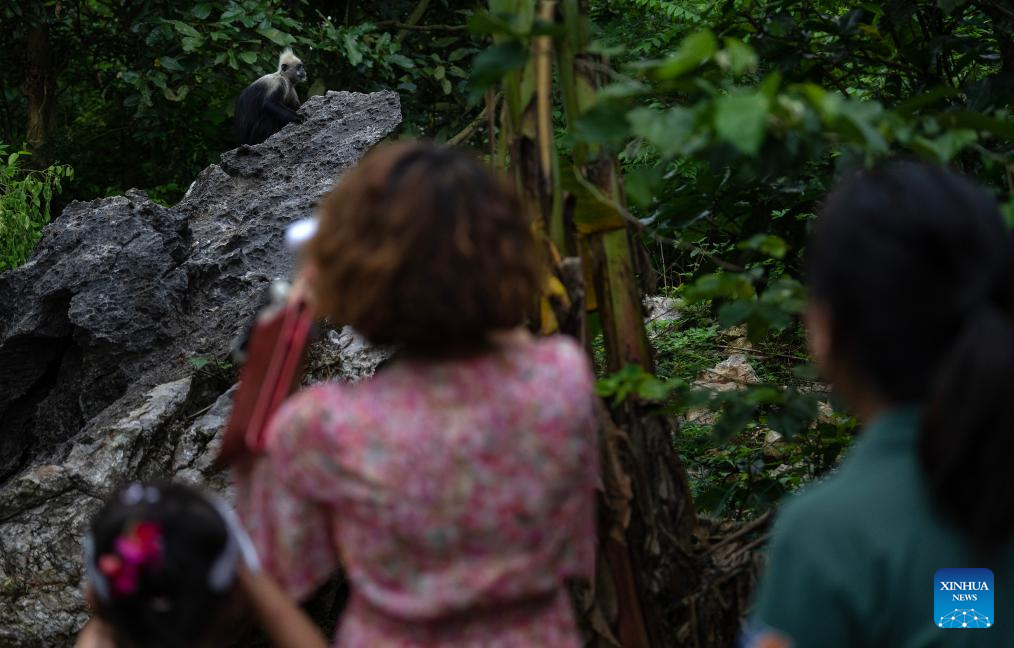
Tourists view a white-headed langur at a national nature reserve in Luobai Town of Jiangzhou District, Chongzuo City, south China's Guangxi Zhuang Autonomous Region, Aug. 5, 2023. The white-headed langur is one of the world's most endangered primate species and exclusive to China. The endangered animal, characterized by the white hair on their heads, are spotted in the karst hills between the Zuojiang and Mingjiang rivers in the city of Chongzuo, Guangxi.
In the 1980s, the population of white-headed langur dwindled to some 300 due to deforestation, land reclamation and poaching. Now the population of the animal has increased to around 1,400. (Xinhua/Fei Maohua)

A white-headed langur leaps at a national nature reserve in Luobai Town of Jiangzhou District, Chongzuo City, south China's Guangxi Zhuang Autonomous Region, Aug. 5, 2023. The white-headed langur is one of the world's most endangered primate species and exclusive to China. The endangered animal, characterized by the white hair on their heads, are spotted in the karst hills between the Zuojiang and Mingjiang rivers in the city of Chongzuo, Guangxi.
In the 1980s, the population of white-headed langur dwindled to some 300 due to deforestation, land reclamation and poaching. Now the population of the animal has increased to around 1,400. (Xinhua/Zhang Ailin)
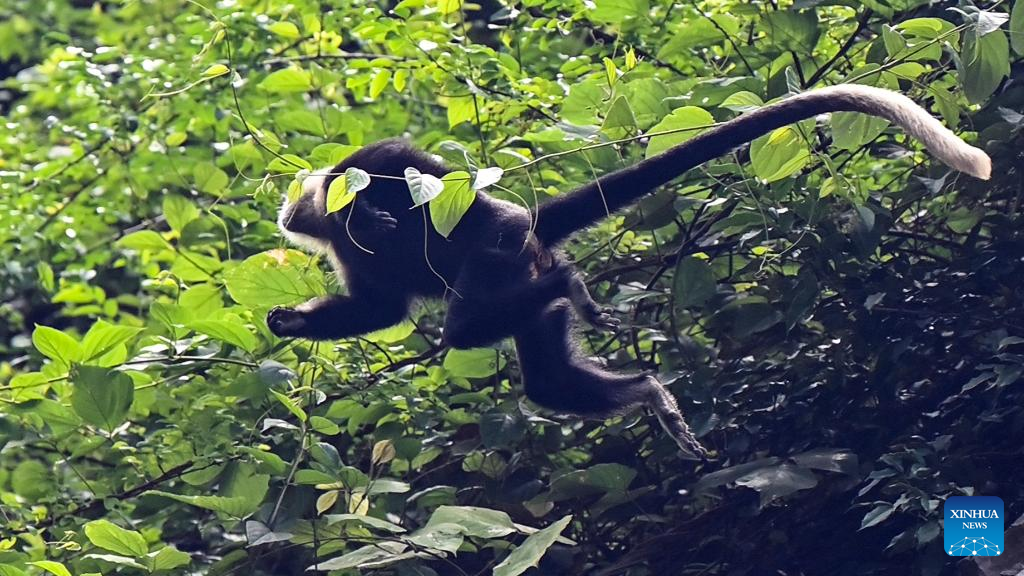
A white-headed langur leaps at a national nature reserve in Luobai Town of Jiangzhou District, Chongzuo City, south China's Guangxi Zhuang Autonomous Region, Aug. 5, 2023. The white-headed langur is one of the world's most endangered primate species and exclusive to China. The endangered animal, characterized by the white hair on their heads, are spotted in the karst hills between the Zuojiang and Mingjiang rivers in the city of Chongzuo, Guangxi.
In the 1980s, the population of white-headed langur dwindled to some 300 due to deforestation, land reclamation and poaching. Now the population of the animal has increased to around 1,400. (Xinhua/Zhang Ailin)

A tourist takes photos of a white-headed langur at a national nature reserve in Luobai Town of Jiangzhou District, Chongzuo City, south China's Guangxi Zhuang Autonomous Region, Aug. 4, 2023. The white-headed langur is one of the world's most endangered primate species and exclusive to China. The endangered animal, characterized by the white hair on their heads, are spotted in the karst hills between the Zuojiang and Mingjiang rivers in the city of Chongzuo, Guangxi.
In the 1980s, the population of white-headed langur dwindled to some 300 due to deforestation, land reclamation and poaching. Now the population of the animal has increased to around 1,400. (Xinhua/Fei Maohua)

A white-headed langur runs past a journalist at a national nature reserve in Luobai Town of Jiangzhou District, Chongzuo City, south China's Guangxi Zhuang Autonomous Region, Aug. 5, 2023. The white-headed langur is one of the world's most endangered primate species and exclusive to China. The endangered animal, characterized by the white hair on their heads, are spotted in the karst hills between the Zuojiang and Mingjiang rivers in the city of Chongzuo, Guangxi.
In the 1980s, the population of white-headed langur dwindled to some 300 due to deforestation, land reclamation and poaching. Now the population of the animal has increased to around 1,400. (Xinhua/Zhou Hua)
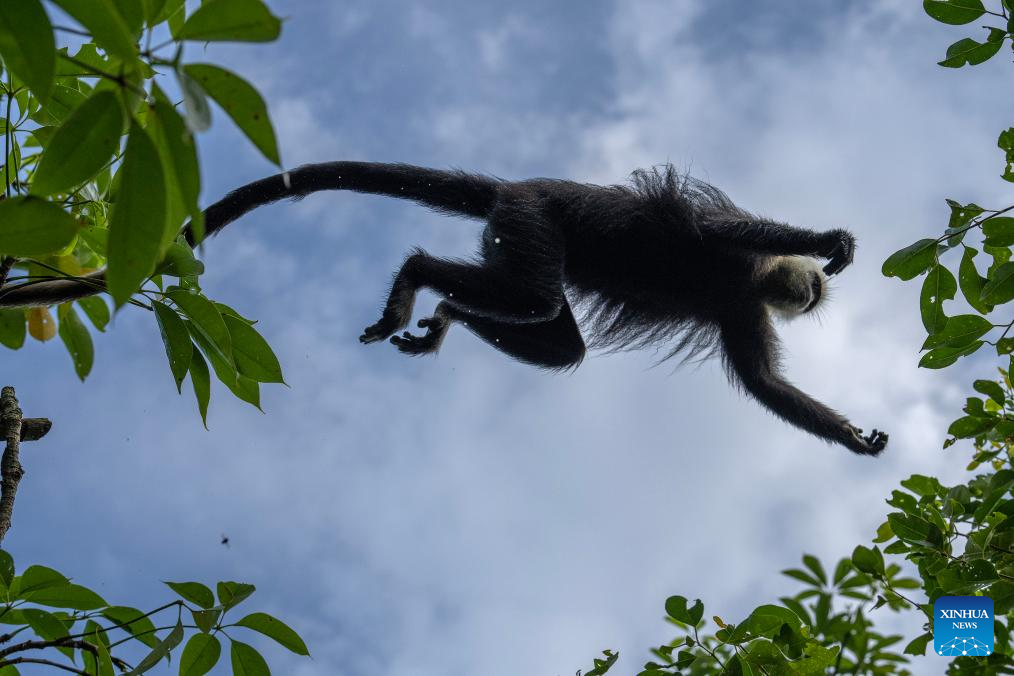
A white-headed langur leaps at a national nature reserve in Luobai Town of Jiangzhou District, Chongzuo City, south China's Guangxi Zhuang Autonomous Region, Aug. 5, 2023. The white-headed langur is one of the world's most endangered primate species and exclusive to China. The endangered animal, characterized by the white hair on their heads, are spotted in the karst hills between the Zuojiang and Mingjiang rivers in the city of Chongzuo, Guangxi.
In the 1980s, the population of white-headed langur dwindled to some 300 due to deforestation, land reclamation and poaching. Now the population of the animal has increased to around 1,400. (Xinhua/Fei Maohua)

A white-headed langur leaps at a national nature reserve in Luobai Town of Jiangzhou District, Chongzuo City, south China's Guangxi Zhuang Autonomous Region, Aug. 5, 2023. The white-headed langur is one of the world's most endangered primate species and exclusive to China. The endangered animal, characterized by the white hair on their heads, are spotted in the karst hills between the Zuojiang and Mingjiang rivers in the city of Chongzuo, Guangxi.
In the 1980s, the population of white-headed langur dwindled to some 300 due to deforestation, land reclamation and poaching. Now the population of the animal has increased to around 1,400. (Xinhua/Zhang Ailin)

A white-headed langur forages at a national nature reserve in Luobai Town of Jiangzhou District, Chongzuo City, south China's Guangxi Zhuang Autonomous Region, Aug. 4, 2023. The white-headed langur is one of the world's most endangered primate species and exclusive to China. The endangered animal, characterized by the white hair on their heads, are spotted in the karst hills between the Zuojiang and Mingjiang rivers in the city of Chongzuo, Guangxi.
In the 1980s, the population of white-headed langur dwindled to some 300 due to deforestation, land reclamation and poaching. Now the population of the animal has increased to around 1,400. (Xinhua/Zhang Ailin)
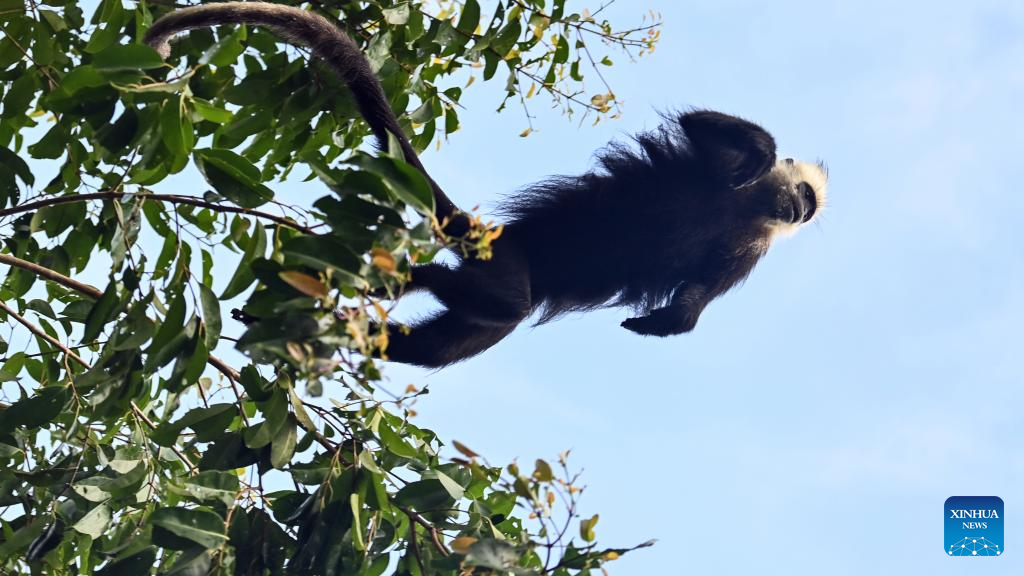
A white-headed langur leaps at a national nature reserve in Luobai Town of Jiangzhou District, Chongzuo City, south China's Guangxi Zhuang Autonomous Region, Aug. 5, 2023. The white-headed langur is one of the world's most endangered primate species and exclusive to China. The endangered animal, characterized by the white hair on their heads, are spotted in the karst hills between the Zuojiang and Mingjiang rivers in the city of Chongzuo, Guangxi.
In the 1980s, the population of white-headed langur dwindled to some 300 due to deforestation, land reclamation and poaching. Now the population of the animal has increased to around 1,400. (Xinhua/Zhang Ailin)

A white-headed langur forages at a national nature reserve in Luobai Town of Jiangzhou District, Chongzuo City, south China's Guangxi Zhuang Autonomous Region, Aug. 4, 2023. The white-headed langur is one of the world's most endangered primate species and exclusive to China. The endangered animal, characterized by the white hair on their heads, are spotted in the karst hills between the Zuojiang and Mingjiang rivers in the city of Chongzuo, Guangxi.
In the 1980s, the population of white-headed langur dwindled to some 300 due to deforestation, land reclamation and poaching. Now the population of the animal has increased to around 1,400. (Xinhua/Zhou Hua)

A white-headed langur leaps at a national nature reserve in Luobai Town of Jiangzhou District, Chongzuo City, south China's Guangxi Zhuang Autonomous Region, Aug. 5, 2023. The white-headed langur is one of the world's most endangered primate species and exclusive to China. The endangered animal, characterized by the white hair on their heads, are spotted in the karst hills between the Zuojiang and Mingjiang rivers in the city of Chongzuo, Guangxi.
In the 1980s, the population of white-headed langur dwindled to some 300 due to deforestation, land reclamation and poaching. Now the population of the animal has increased to around 1,400. (Xinhua/Zhang Ailin)
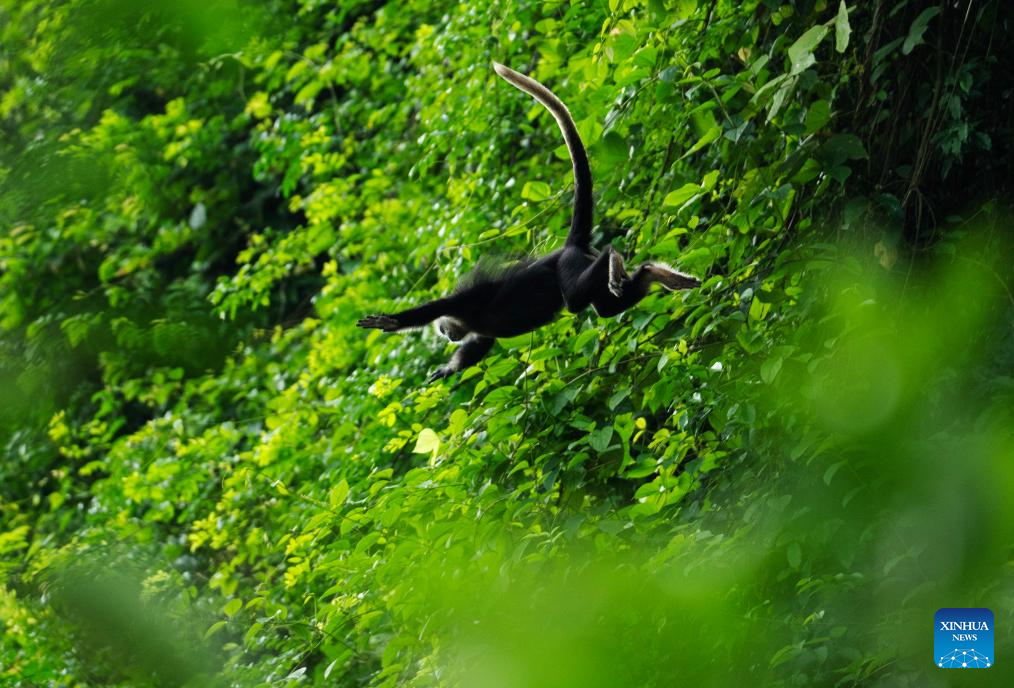
A white-headed langur leaps at a national nature reserve in Luobai Town of Jiangzhou District, Chongzuo City, south China's Guangxi Zhuang Autonomous Region, Aug. 5, 2023. The white-headed langur is one of the world's most endangered primate species and exclusive to China. The endangered animal, characterized by the white hair on their heads, are spotted in the karst hills between the Zuojiang and Mingjiang rivers in the city of Chongzuo, Guangxi.
In the 1980s, the population of white-headed langur dwindled to some 300 due to deforestation, land reclamation and poaching. Now the population of the animal has increased to around 1,400. (Xinhua/Fei Maohua)
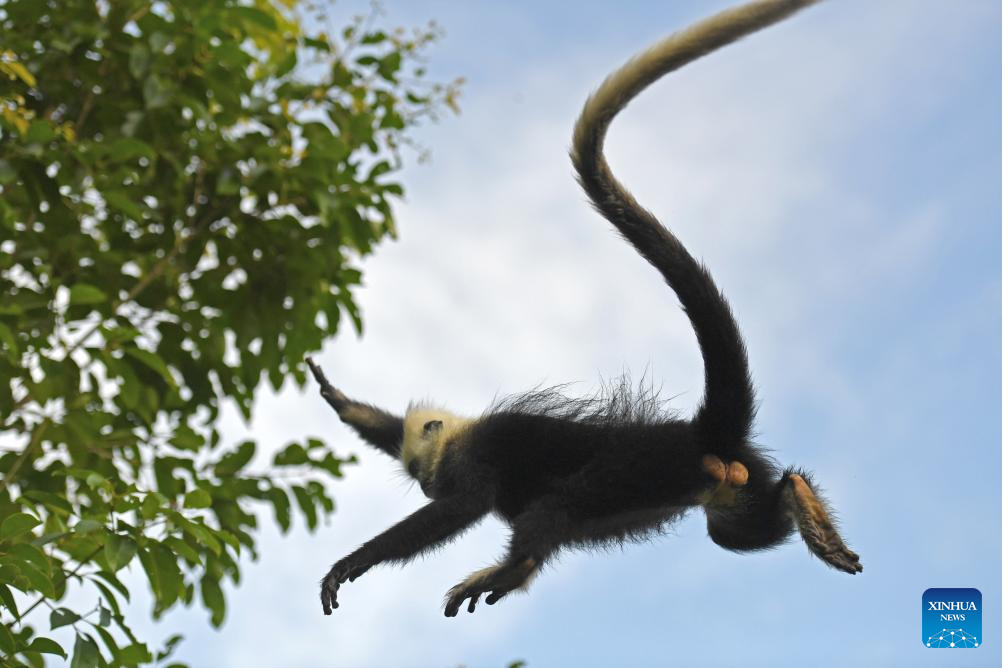
A white-headed langur leaps at a national nature reserve in Luobai Town of Jiangzhou District, Chongzuo City, south China's Guangxi Zhuang Autonomous Region, Aug. 5, 2023. The white-headed langur is one of the world's most endangered primate species and exclusive to China. The endangered animal, characterized by the white hair on their heads, are spotted in the karst hills between the Zuojiang and Mingjiang rivers in the city of Chongzuo, Guangxi.
In the 1980s, the population of white-headed langur dwindled to some 300 due to deforestation, land reclamation and poaching. Now the population of the animal has increased to around 1,400. (Xinhua/Zhou Hua)

A white-headed langur leaps at a national nature reserve in Luobai Town of Jiangzhou District, Chongzuo City, south China's Guangxi Zhuang Autonomous Region, Aug. 5, 2023. The white-headed langur is one of the world's most endangered primate species and exclusive to China. The endangered animal, characterized by the white hair on their heads, are spotted in the karst hills between the Zuojiang and Mingjiang rivers in the city of Chongzuo, Guangxi.
In the 1980s, the population of white-headed langur dwindled to some 300 due to deforestation, land reclamation and poaching. Now the population of the animal has increased to around 1,400. (Xinhua/Zhang Ailin)
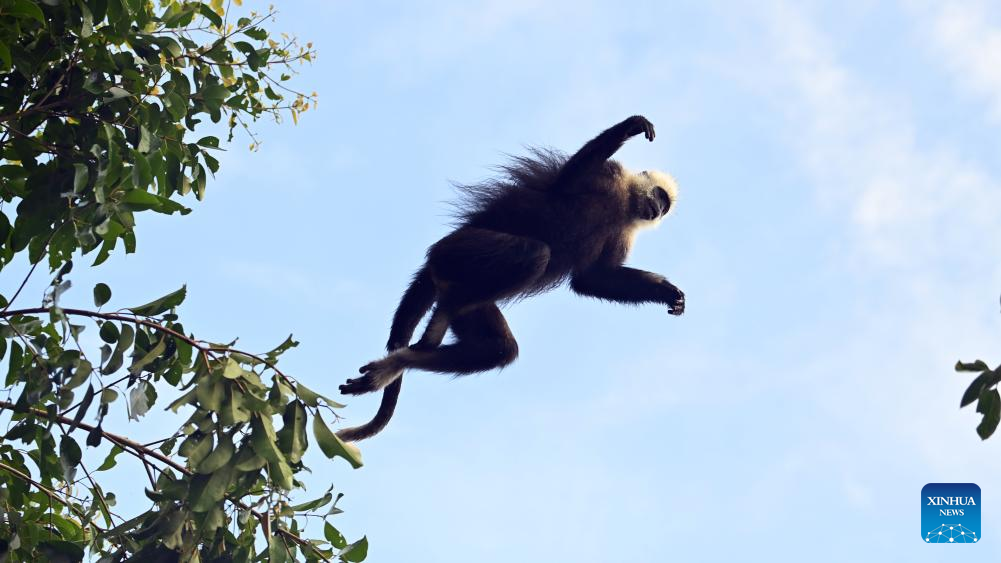
A white-headed langur leaps at a national nature reserve in Luobai Town of Jiangzhou District, Chongzuo City, south China's Guangxi Zhuang Autonomous Region, Aug. 5, 2023. The white-headed langur is one of the world's most endangered primate species and exclusive to China. The endangered animal, characterized by the white hair on their heads, are spotted in the karst hills between the Zuojiang and Mingjiang rivers in the city of Chongzuo, Guangxi.
In the 1980s, the population of white-headed langur dwindled to some 300 due to deforestation, land reclamation and poaching. Now the population of the animal has increased to around 1,400. (Xinhua/Zhang Ailin)



